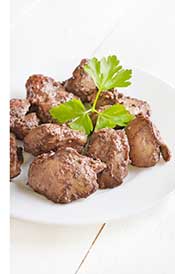
Chicken liver is one of the most nutrient-rich foods on the planet.
Although organ meats are not as popular as they once were, chicken liver is full of essential nutrients.
This article will provide a research-backed guide to the nutrition profile, health benefits, and concerns.
Additionally, we will look at how to cook chicken livers for the best possible taste.
What Is Chicken Liver?
Firstly, chicken liver is not red or white meat; instead, we classify it as organ meat (offal).
Organ meats are incredibly nutritious, and they offer far more nutritional value than regular muscle meat.
In fact, organs contain such a significant amount of nutrients that we can “overdose” on some of them if we consume them every day.
Despite their impressive nutrition profile, not many people eat organ meats compared to in the past.
Chicken liver enjoys nowhere near the popularity of chicken breast, but it offers substantially more nutritional value.
Note: For those who dislike the taste, pâté is an excellent way to consume “hidden” liver.
See this guide to pâté for more information.
Nutrition Facts
With data sourced from the USDA nutrient database, here is the full nutrition profile of chicken liver (cooked) per 100 grams (1).
Calories and Macros
| Amount (kcal/grams) | |
| Calories | 167 kcal |
| Carbohydrate | 0.9 g |
| Fiber | 0 g |
| Sugar | 0 g |
| Fat | 4.8 g |
| Saturated Fat | 1.6 g |
| Monounsaturated Fat | 1.2 g |
| Polyunsaturated Fat | 1.3 g |
| Omega-3 | Trace amounts |
| Omega-6 | 749 mg |
| Protein | 24.5 g |
Chicken liver is rich in protein and has a protein-density of approximately 25%.
Additionally, it contains a moderate amount of dietary fat and minimal levels of carbohydrate.
Vitamins
| Amount (% RDA) | |
| Vitamin B12 | 281 % |
| Vitamin A | 267 % |
| Folate | 144 % |
| Vitamin B2 | 117 % |
| Vitamin B5 | 67 % |
| Vitamin B3 | 55 % |
| Vitamin C | 47 % |
| Vitamin B6 | 38 % |
| Vitamin B1 | 19% |
| Vitamin E | 4 % |
As shown above, chicken liver is a significant source of several important vitamins.
Furthermore, it is a surprising source of vitamin C; regular muscle meat does not contain this nutrient, but organ meats do.
It is also worth noting that the USDA’s nutrient database does not offer values for vitamin D or vitamin K2.
However, chicken liver contains both of these vitamins in small to moderate amounts (2, 3).
Minerals
| Amount (% RDA) | |
| Selenium | 118 % |
| Iron | 65 % |
| Phosphorus | 41 % |
| Zinc | 27 % |
| Copper | 25 % |
| Manganese | 18 % |
| Potassium | 8 % |
| Magnesium | 6 % |
| Sodium | 3 % |
| Calcium | 1 % |
Chicken liver offers a decent range of essential minerals, and it is particularly high in selenium and iron.
As the tables show, chicken liver provides a substantial range of micronutrients. It’s an excellent option for anyone looking for what to eat to increase their vitamin and mineral intake.
Health Benefits
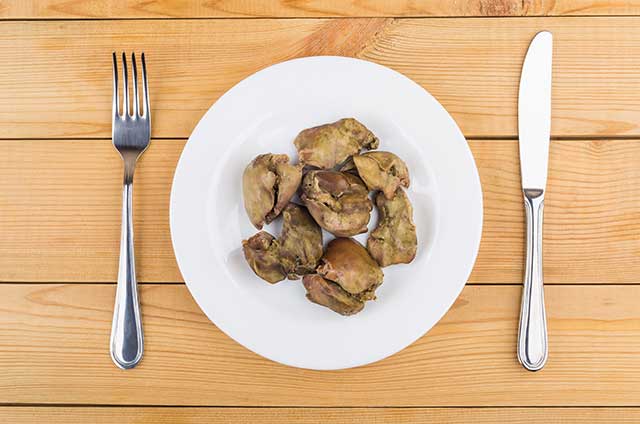
1) Chicken Liver Is Loaded With B Vitamins
B vitamins have an important role in energy production, and part of their job involves deriving energy from the nutrients in our food (4).
Additionally, the B vitamin group is essential for the optimal functioning of our cells, and these vitamins have a crucial part to play in cell repair and DNA synthesis (5).
Chicken liver contains enormous amounts of the vitamin B12, with just 100 grams providing 287% of the recommended daily allowance.
Vitamin B12 is involved in numerous biological processes, including but not limited to its central role in the DNA, energy, and nervous systems.
Since this vitamin is so critical for our health, B12 deficiency has been associated with an increased risk of cardiovascular disease, depression, and dementia (6, 7, 8).
2) Substantial Source of Selenium
Chicken liver provides significant amounts of the essential mineral selenium, offering more than 100% of the RDA per 100 grams.
Selenium is an essential mineral that has antioxidant properties, and it is critical for the optimal function of the thyroid gland (9, 10).
There is also research that suggests selenium can enhance DNA repair, which may potentially help to reduce the risk of cancer and illnesses related to damaged DNA (11).
A wide range of foods contain selenium, but in plant foods, this content can be influenced by the selenium-density of the soil in which they grow.
In contrast, chicken liver guarantees a substantial serving of selenium.
3) Rich In Protein
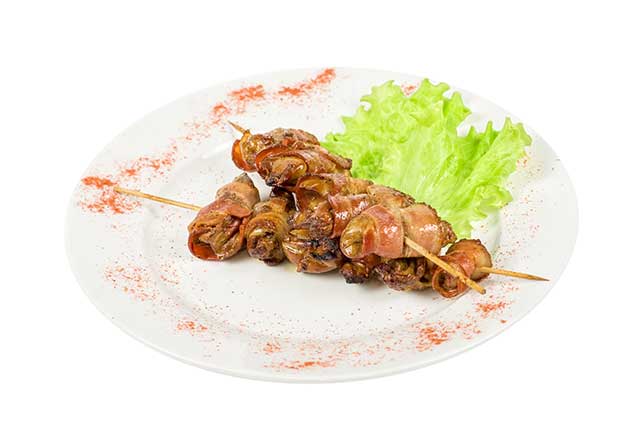
Protein is important for many aspects of our health.
Similar to most animal foods, chicken liver is a rich source of dietary protein, containing 24.5 grams protein per 100 grams.
The protein in chicken liver is a “complete” protein, which means that it contains all nine of the amino acids that we require from our diet (12).
These amino acids work as the building blocks for our body, and they are involved in everything from the growth and repair of our cells to hormone production and muscle building.
Additionally, chicken liver contains fewer calories than many other types of meat;
| Type of Meat | Calories Per 100 Grams |
| Beef (Ribeye) | 291 (13) |
| Beef (Ground – 80% Lean) | 254 (14) |
| Chicken Breast | 165 (15) |
| Chicken Thigh (Skinless) | 217 (16) |
| Chicken Liver | 167 (17) |
| Pork (Loin Chop) | 197 (18) |
Simply being lower in calories is not something we should use to judge the respective health properties of food.
However, what this table does show is that chicken liver is more protein-dense than many other animal foods.
Chicken liver and chicken breast share a similar protein density, but the former is much higher in vitamins and minerals.
4) A Rare Non-Plant Source of Vitamin C
Ask anyone to name a source of vitamin C, and the answer will probably be an orange or a lemon.
However, it is not only fruit—or even plants—that provide vitamin C.
Notably, organ meats are a rich source of this essential vitamin, and chicken liver contains 47% of the RDA of vitamin C per 100 grams.
A moderate-size 200-gram serving would offer the full RDA for the vitamin.
This vitamin C content is just one of the advantages organ meats have over regular muscle meat; they offer the same protein content, but so much more in the way of vitamins and minerals.
For another organ meat high in vitamin C, it may be worth looking into sweetbreads.
5) Chicken Liver Contains Large Amounts of Retinol (Vitamin A)
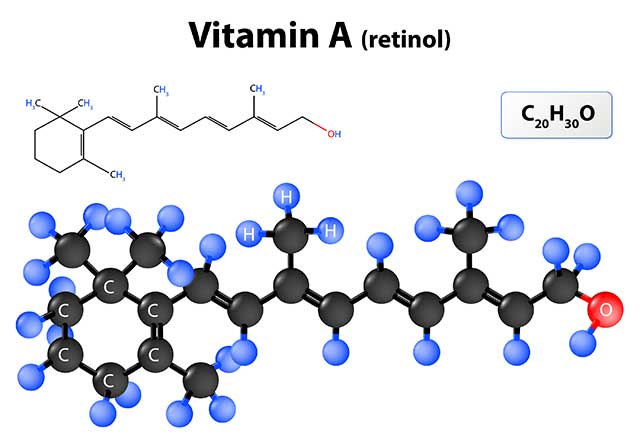
There are two types of vitamin A that we can obtain from our diet;
Retinol
The nutrient retinol is otherwise known as ‘pre-formed vitamin A,’ and it is present in animal foods such as eggs, oily fish, and organ meats.
Retinol is highly bioavailable, and we can use it in its natural state to meet our vitamin A requirements (19).
Carotenoids
Carotenoids are sometimes called ‘provitamin A,’ and they are a precursor to the retinol that we can find in animal foods.
Typical sources include orange-fleshed fruit and vegetables such as carrots, pumpkins, and sweet potatoes.
Unlike retinol, carotenoids are not bioavailable and need converting to retinol inside the body before we can use them.
On the downside, some people have genes that limit their ability to convert carotenoids into retinol (20).
Vitamin A In Chicken Liver
Positively, chicken liver contains retinol, which is the “ready to use” form of vitamin A.
Furthermore, chicken livers provide an exceptional amount of this vitamin, offering 267% of the RDA per 100 grams.
Vitamin A is especially important for our vision and keeping our eyes healthy, and it also plays a role in immune health (21, 22).
Concerns and Drawbacks
Although chicken liver is a health food that provides a great deal of nutritional value, there are some legitimate concerns about it.
Vitamin A: How Much Is Too Much?
The belief that we “can never eat too much healthy food” is wrong, and especially so when it comes to organ meat.
When we eat fat-soluble vitamins (such as vitamins A, D, E, and K), our body stores them, and in high enough doses, they can accumulate to reach excessive and potentially harmful levels over time.
Regarding vitamin A specifically, our liver stores this fat-soluble vitamin for future use, and it is cleared from the body very slowly.
As a result, and with prolonged high consumption, these vitamin A stores can build up to a level where they cause toxicity.
Hypervitaminosis A
This vitamin A toxicity is otherwise known as hypervitaminosis A, and it can cause a range of problems ranging from the mild (itchy skin and headaches) to the severe (liver damage and coma) (23).
Usually, this condition is the result of chronic high-dose supplementation with vitamin supplements. However, excessive consumption of retinol-rich food can also be a cause.
Specific side effects from excessive vitamin A can even become apparent at intake levels only slightly higher than the RDA (24).
This being the case, we shouldn’t over-consume organ meats.
For this reason, eating a regular 150-gram serving of chicken liver once or twice per week is more than enough to experience all the benefits it offers.
How To Cook Chicken Livers
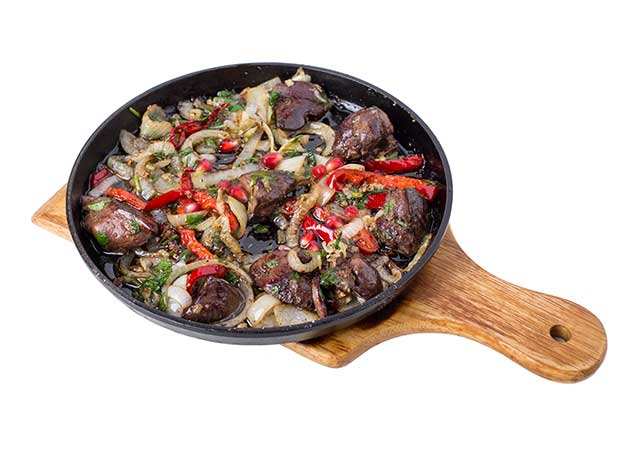
While the health benefits of chicken liver are well known, the taste can be a problem for some people.
In short; organ meats may be more nutritious than regular meat, but they don’t taste as good.
However, chicken liver has one of the mildest flavors among organ meats, so it could be a good option for people who dislike the taste of beef liver.
Furthermore, there are a few cooking methods and recipes we can use to improve the taste.
First, it is a good idea to marinate liver in something acidic for a few hours before cooking. This acidic solution breaks down the fibers in the liver and tenderizes the meat.
Some good acidic marinading options include red wine vinegar, balsamic vinegar, and pure squeezed lemon juice.
1) Chicken Liver, Garlic, and Onions
For this recipe, saute the chicken livers in a pan with butter.
Add some garlic, mushrooms, and onions to the pan and saute until everything is almost cooked.
Reduce the heat, and add some red wine vinegar, salt, and black pepper to the pan and heat steadily until done.
2) Chicken Liver and Bacon Pate
If you do not like the taste of liver, then hiding it in a tasty pate can be a good way to consume it.
By making a pate, you can blend the liver into a mixture full of delicious ingredients.
Ingredients
- 1 stick (113 g) butter
- 1/2 lb (227 g) chicken liver
- 7 oz (200 g) bacon
- 1 medium onion
- 5 cloves of garlic
- Pinch of sage and thyme
- Salt and pepper to season
Fortunately, making a pate is reasonably straightforward.
To start with, add some butter to a pan and heat it up before adding the chicken livers.
After this, add the bacon and some garlic and onions to the pan and cook thoroughly.
A few minutes before everything is ready, add the salt, pepper, sage, and thyme to the pan for seasoning. Mix everything in and take off the heat once fully cooked.
Next, transfer all the food into a food processor and pulverize it. Once the resulting paste is smooth and consistent, put the pate into a container and store in the refrigerator.
Over a few hours, the pate will harden, and it last for a few days.
Final Thoughts
Overall, the data in this article shows that chicken liver is one of the most nutritious and healthy foods we can eat.
Chicken liver is incredibly nutrient-dense, and it can contribute significantly to our essential nutrient requirements.
Although there are some potential concerns about vitamin A toxicity, this is only a problem if our consumption is truly in excess.
At the end of the day, the benefits of eating chicken liver far outweigh the drawbacks.
For more nutrient-dense organ meat, see this guide to liverwurst.

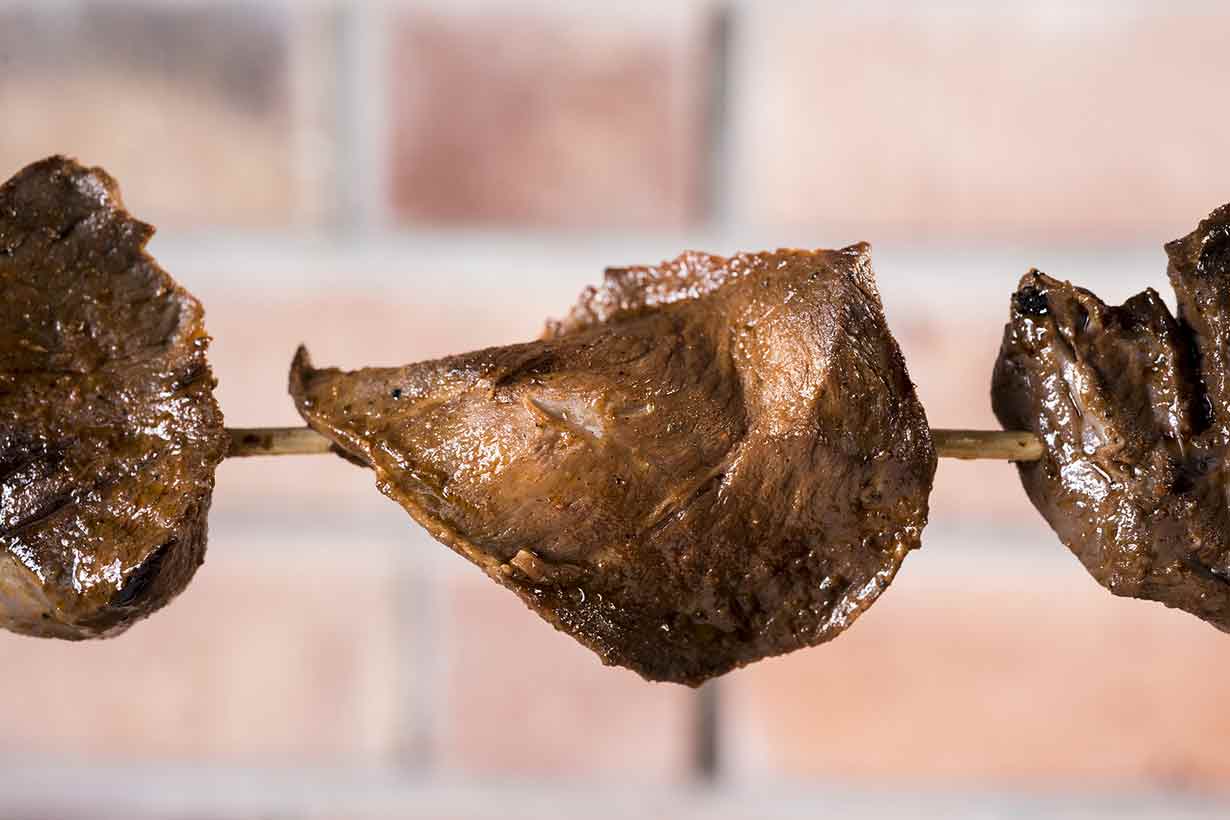
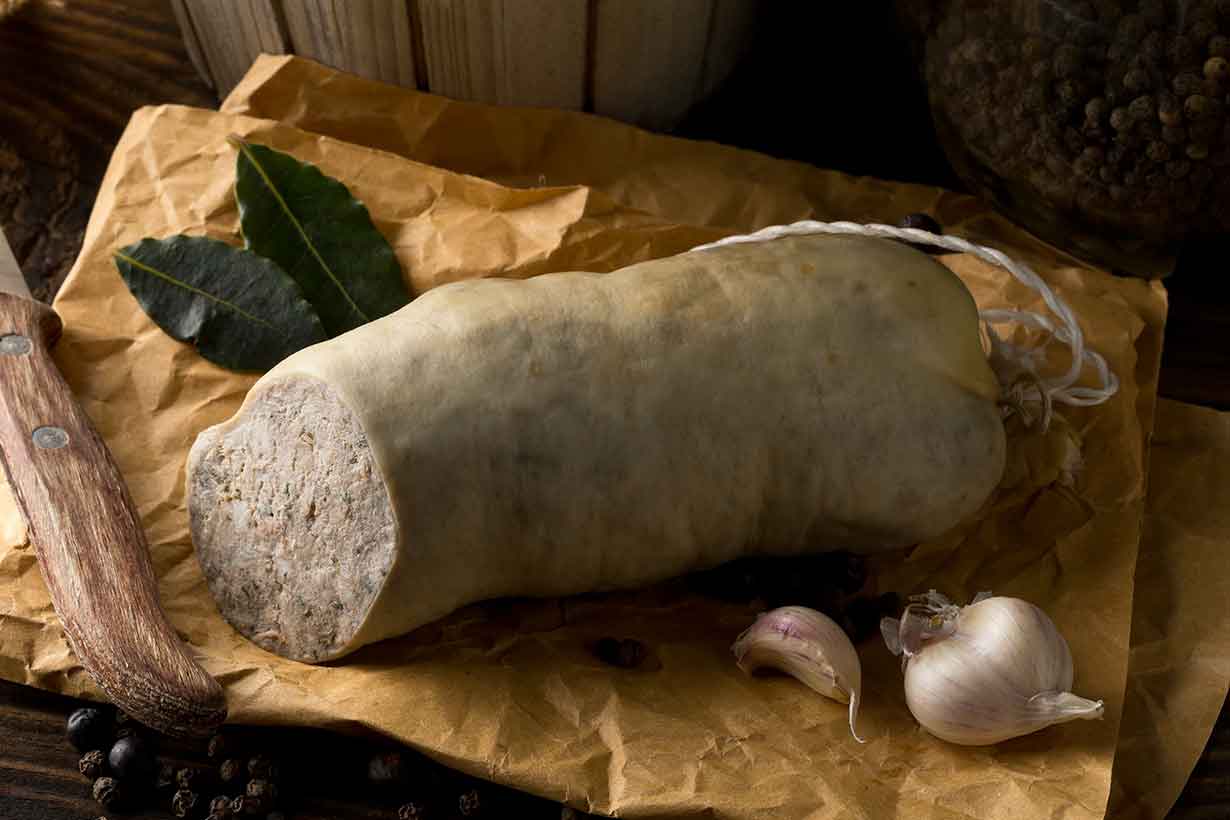
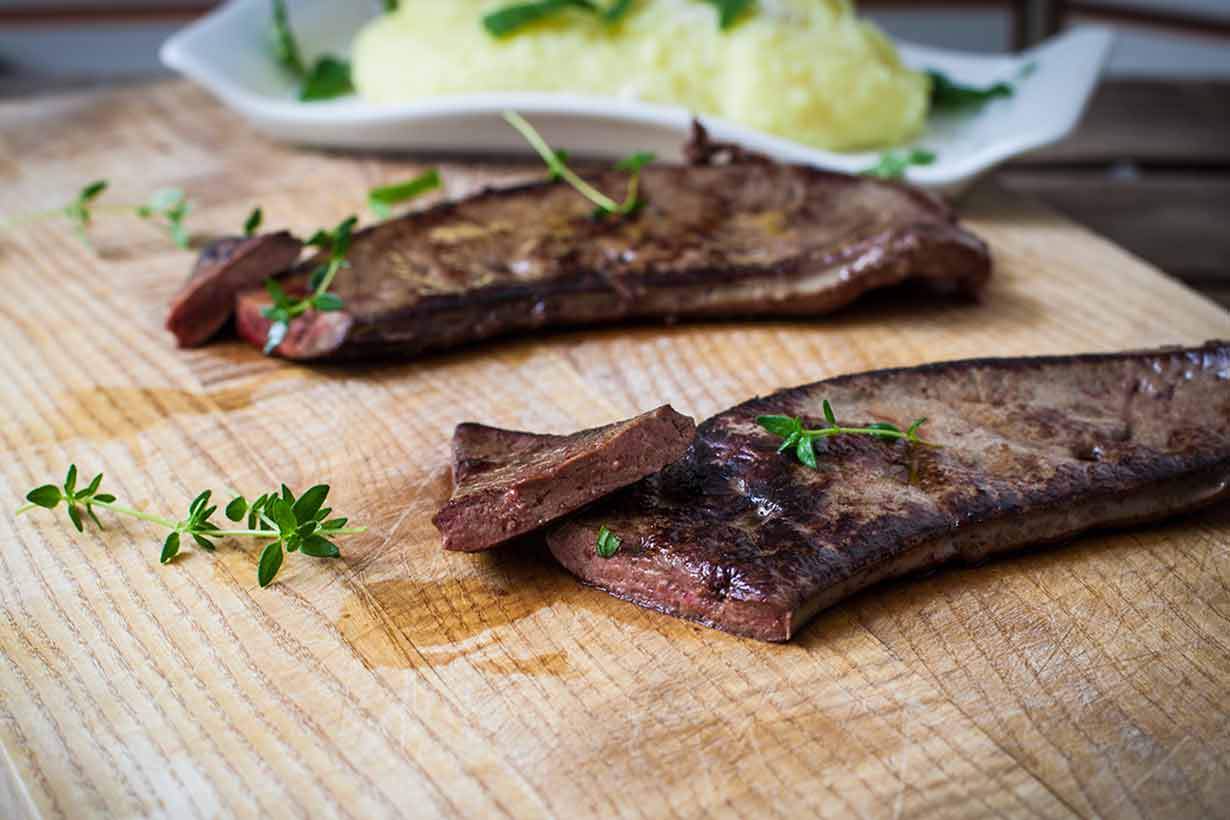


We love liver, albeit, an infrequent entree. M.
That (loving it) seems a rare thing these days…
BEST place to eat chicken livers Charley B’s in Bridgeport, AL. I, thanks to my Dad, LOVE chicken livers. Dad would sometimes fry chicken livers for us for a night time snack. 😋 We don’t like ’em deep fried. At Charley B’s they prepare them on the top of the grill WITH onions! My parents & I often go Sunday for lunch after Church.
Sounds great. I checked out this place you mentioned, and it looks good! A bit far for me, though…
Well, I cook my chicken liver with 1/2 cup of vinegar, 1/4 cup of soy sauce, chopped garlic, onion pepper, mix them all together with the liver, then put in a pan, cook it covered till boiling. Turn down the heat until the juice almost evaporates but leave a bit of juice, mix well. Enjoy! Eat with a 1/2 cup of basmati rice.
That sounds like a tasty way to prepare it!
Yes love chicken liver, and make my own pate (with a bit of cognac added). Also I love all offal from other animals. How do lambs liver, kidneys hearts compare to chicken livers with regards vitamins etc.
Pate is great.
Lamb is actually even more nutrient-dense. Pretty much lamb anything tends to beat beef, chicken, or any other common meat for nutritional value – it’s probably all the grass they eat.
I try to get organic chicken liver and I cook a 50 or 70 grams per serving,m
I fry the onion with some avocado oil,
then I add the chopped liver, while still the liver is tender, add some tomato paste,
auste well, and at the end add some salt and pepper,
ummm, yummy
That sounds tasty – I’ll give it a try!
I’m severely anemic and can’t take iron supplements so am trying to eat an iron rich diet. I was considering eating chicken livers everyday instead of a supplement but an concerned about the vit A toxicity threat 🙁
Hi Marika
In addition to liver, some other significant food sources of iron include clams, oysters, mussels, fish eggs, and kidney meat.
Hi i use chicken liver as my protein source in foods because of it’s cost since i cant aford tk eat regular meat every day. Should i be concerned about the vitamin A (or other) excess ?? What should i be on the lookout to know when im eating too much?? Thanks!!
Linus Pauling has a good summary of the risks from excessive vitamin A here: https://ods.od.nih.gov/factsheets/VitaminA-HealthProfessional/#h8
Or you can see some of the symptoms of overdose here: https://www.healthline.com/health/hypervitaminosis-a#symptoms
I personally wouldn’t eat chicken liver every day, and I’d maybe look at some other budget protein options such as frozen ground meat, bulk chicken legs/thighs, and canned sardines. Asking a local butcher if they have any cheap offcuts could be a good option too – I think most will put something together.
I rinse the chicken livers, then I dredge them in flour, put them in a hot buttered frying pan and fry until crisp on the outside. Now that is a real treat!!
Sounds tasty!